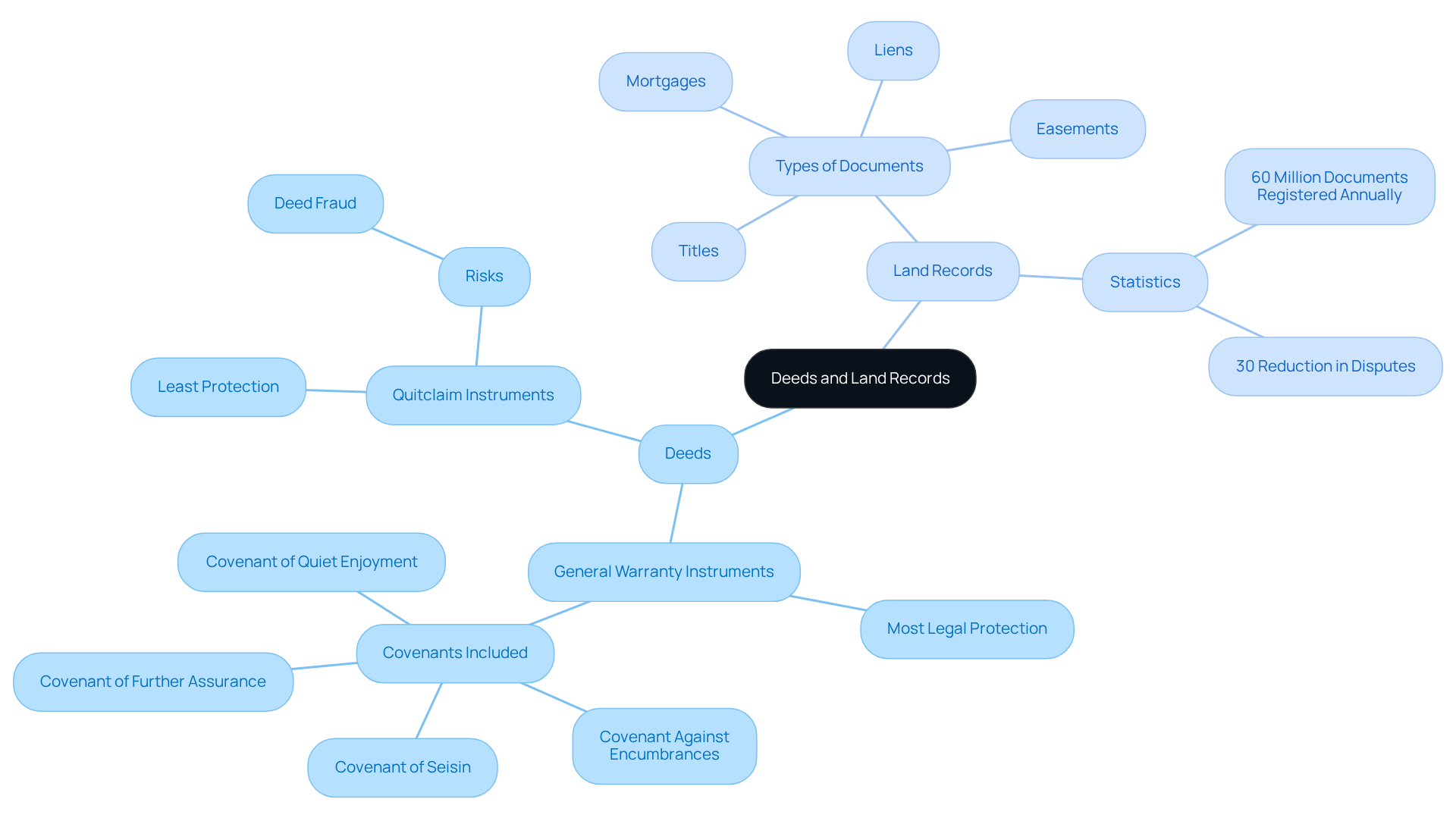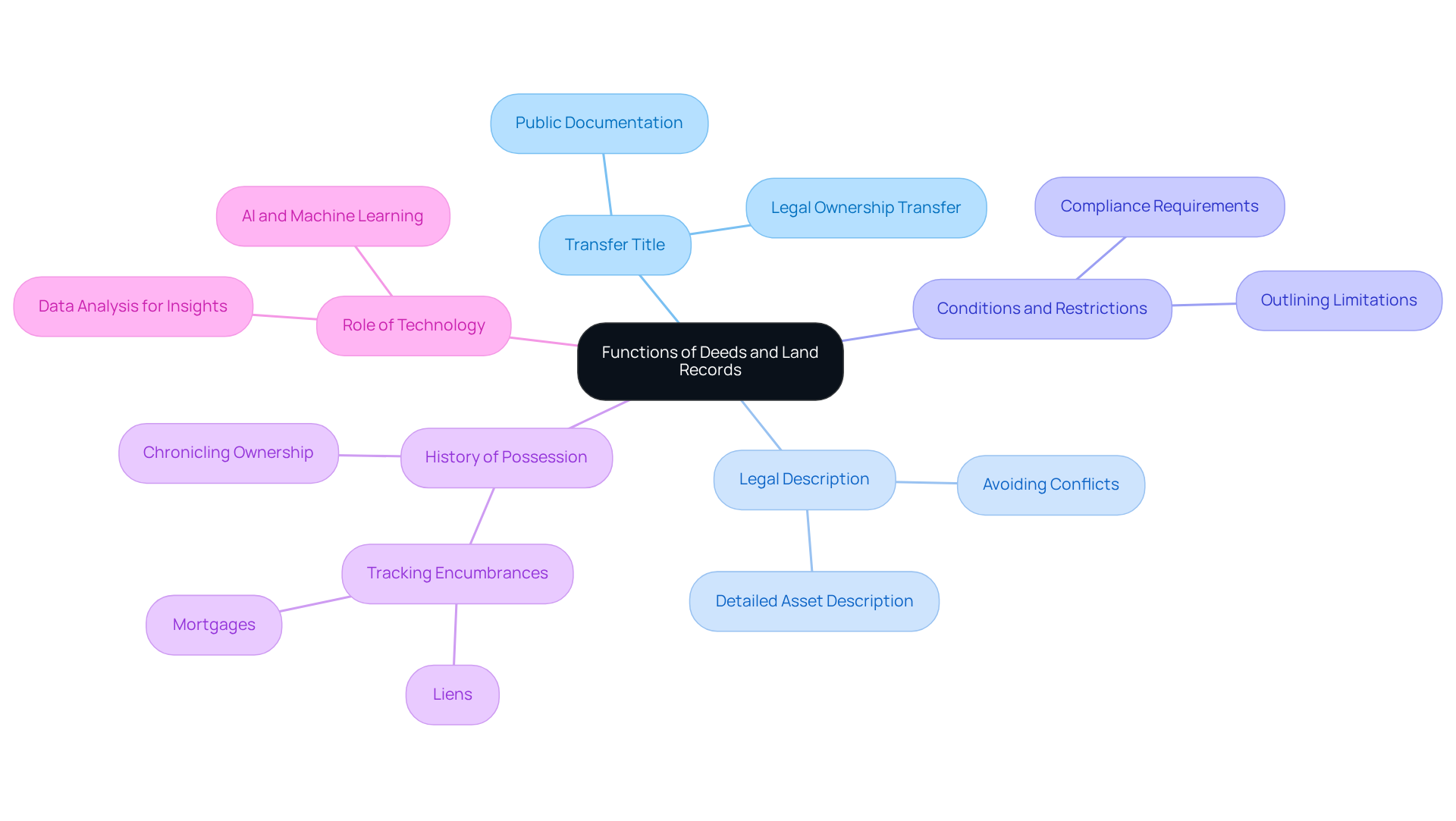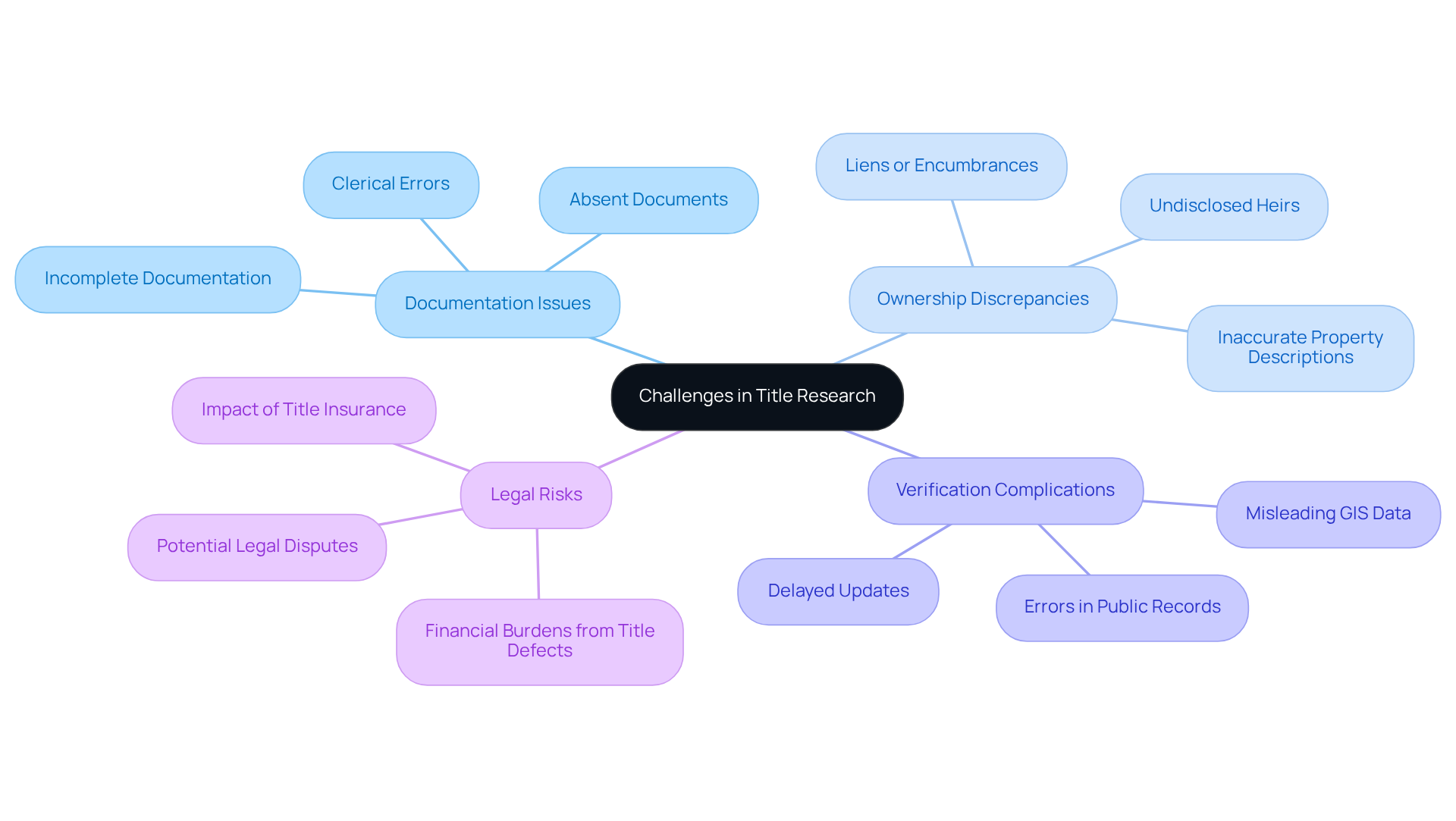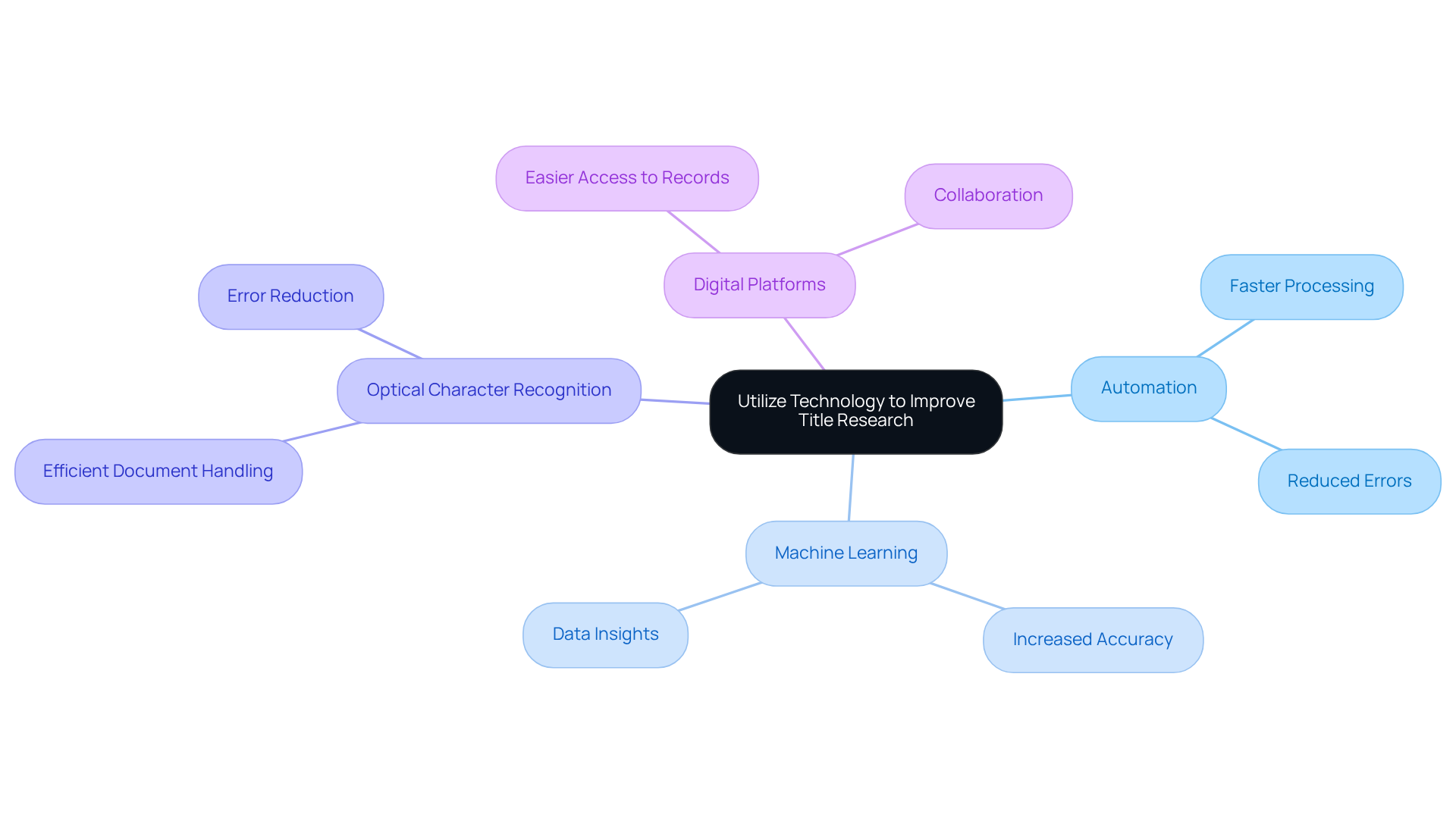Overview
The article elucidates that deeds are formal legal documents essential for transferring property titles and delineating associated rights. In contrast, land records encompass a broader spectrum of public documents that chronicle property ownership history and claims. This distinction is pivotal for real estate transactions; deeds furnish specific details regarding title transfers, while land records provide comprehensive documentation of all related property claims and encumbrances. Consequently, this thorough approach mitigates disputes and ensures legal compliance.
Introduction
Understanding the nuances between deeds and land records is crucial for anyone navigating the real estate landscape. Deeds serve as the formal legal instruments that transfer property ownership. In contrast, land records encompass a wider array of documents that chronicle the history and claims associated with a property. As the complexity of real estate transactions continues to grow, so does the potential for misunderstandings and disputes. Consequently, individuals must ensure they are adequately informed about these essential documents to avoid pitfalls in their property dealings.
Define Deeds and Land Records
A document serves as a formal legal instrument that conveys title of real estate from one individual, known as the grantor, to another, referred to as the grantee. This document not only acts as evidence of possession but also outlines the rights and duties associated with the asset. In contrast, land documentation encompasses a broader range of public papers, including titles, mortgages, liens, and easements. These documents are meticulously preserved by government agencies and play a crucial role in establishing the history of property possession and any claims against it.
Each year, approximately 60 million documents are registered across the United States, underscoring their significance in real estate transactions. Furthermore, the digitization of these documents has substantially reduced title conflicts by creating a verifiable chain of possession, demonstrated to lower the occurrence of disputes by as much as 30%. Understanding the difference between deeds and land records is essential for navigating the complexities of real estate dealings and ensuring compliance with legal obligations.
Various types of documents, such as and quitclaim instruments, offer differing levels of security and implications for real estate. Additionally, potential risks associated with deed transfers, including deed fraud, highlight the necessity of meticulous documentation and verification in real estate transactions.

Explore Functions of Deeds and Land Records
Deeds serve several key functions in real estate transactions: they transfer title, provide a legal description of the asset, and outline any conditions or restrictions related to the asset. Furthermore, land documents fulfill an auxiliary role by chronicling the history of possession and any encumbrances on the asset, such as mortgages or liens. They guarantee clarity in real estate dealings and assist in avoiding conflicts by offering public documentation of possession.
As noted by Suze Orman, possessing a home is a cornerstone of wealth, underscoring the significance of precise documents and land titles in determining property rights. The difference between deeds and land records is fundamental in real estate law, as they work together to ensure that rights of possession are distinctly outlined and legally binding.
In addition, advanced technologies such as AI and machine learning are increasingly employed to analyze property data, providing insights into long-term investment potential and market dynamics. This highlights the in the real estate sector.

Identify Challenges in Title Research
Title investigation presents various challenges, including incomplete or inconsistent documentation and discrepancies in ownership details. Common issues encountered during the verification process include absent documents, clerical errors in public records, and the presence of liens or encumbrances that may not be immediately evident. Notably, more than one-third of U.S. residential real estate transactions encounter that must be resolved prior to closing, highlighting the prevalence of these challenges.
Furthermore, discrepancies in property descriptions, such as inaccurate square footage or the number of bedrooms, can complicate the verification process and impede buyers' ability to secure financing. As Randy Olson emphasizes, inaccuracies in public records can lead to significant problems for buyers, underscoring the necessity for thorough investigations.
Title researchers frequently note that minor errors can escalate into substantial legal disputes regarding ownership. Moreover, recognizing the importance of title insurance is essential, as it can cover legal costs and losses stemming from title defects, providing a vital layer of protection. Grasping these complexities is imperative for title researchers and real estate professionals to navigate transactions effectively and mitigate potential risks.

Utilize Technology to Improve Title Research
Technology plays a pivotal role in enhancing title research by . Machine learning algorithms and optical character recognition tools can rapidly process extensive volumes of title documents, identifying key information and discrepancies with greater accuracy than traditional manual methods. Furthermore, digital platforms facilitate easier access to land records and help illustrate the difference between deeds and land records, promoting collaboration among title researchers. By leveraging these advanced technologies, real estate professionals can significantly enhance their workflows, reduce the time spent on research, and minimize the risk of errors. Consequently, this leads to more efficient and reliable property transactions.

Conclusion
Understanding the distinction between deeds and land records is essential for anyone involved in real estate transactions. Deeds serve as the formal legal instruments that transfer property ownership, while land records encompass a broader array of public documents that track the history and claims associated with real estate. This knowledge not only aids in navigating the complexities of property transactions but also ensures compliance with legal requirements, ultimately protecting the rights of all parties involved.
Key points have been highlighted throughout the article, including:
- The various functions of deeds and land records
- The challenges faced during title research
- The transformative role of technology in improving these processes
The importance of accurate documentation cannot be overstated; errors or inconsistencies in property records can lead to significant legal disputes and financial loss. Furthermore, the integration of advanced technologies is revolutionizing title research, enabling professionals to conduct more efficient and reliable transactions.
In light of these insights, it is crucial for real estate professionals and potential buyers alike to prioritize a thorough understanding of deeds and land records. By doing so, they can mitigate risks, enhance their decision-making processes, and ultimately contribute to a more transparent and secure real estate market. Embracing technology and staying informed about the intricacies of property documentation will empower stakeholders to navigate the real estate landscape with confidence and clarity.
Frequently Asked Questions
What is a deed in real estate?
A deed is a formal legal document that conveys the title of real estate from one individual (the grantor) to another (the grantee). It serves as evidence of possession and outlines the rights and duties associated with the property.
What are land records?
Land records refer to a broader range of public documents related to real estate, including titles, mortgages, liens, and easements. These documents are preserved by government agencies and are essential for establishing the history of property possession and any claims against it.
How many documents are registered each year in the United States?
Approximately 60 million documents are registered each year across the United States, highlighting their importance in real estate transactions.
How has digitization impacted land records?
The digitization of land records has significantly reduced title conflicts by creating a verifiable chain of possession, which has been shown to lower the occurrence of disputes by as much as 30%.
Why is it important to understand the difference between deeds and land records?
Understanding the difference between deeds and land records is crucial for navigating the complexities of real estate dealings and ensuring compliance with legal obligations.
What are some types of deeds mentioned in the article?
Types of deeds mentioned include general warranty instruments and quitclaim instruments, which provide differing levels of security and implications for real estate transactions.
What risks are associated with deed transfers?
Potential risks associated with deed transfers include deed fraud, underscoring the necessity of meticulous documentation and verification in real estate transactions.




